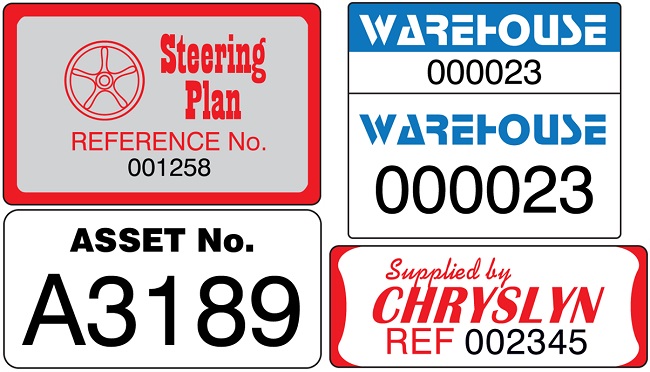
If you're not wholly familiar with the wide world of asset tagging, you may be surprised to see just how many different types of asset label there are. Asset marking isn't a one-size-fits-all industry; as an asset label supplier, we at Label Source have to be extremely flexible in the range that we offer.
For example...
High-security asset labels

Many of our clients request an asset labelling solution that will make it difficult for would-be thieves to remove the asset labels from the goods to which they're affixed. We have two different options for these customers: destructible asset labels, which frament on attempted removal (see image above), and tamper-evident asset labels, which leave behind a permanent pattern when removed. Both types of label make it nigh-impossible to completely eliminate the evidence of theft.
Two-part asset tags
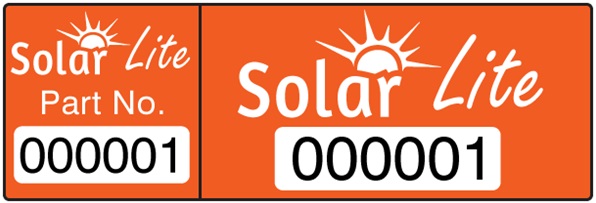
Many business owners need two copies of each asset label: one label for the assets themselves, and a corresponding label for their records. Our dual asset labels were designed with these people in mind - each one is made up of two detachable parts, each bearing the same information.
Extra-large asset labels
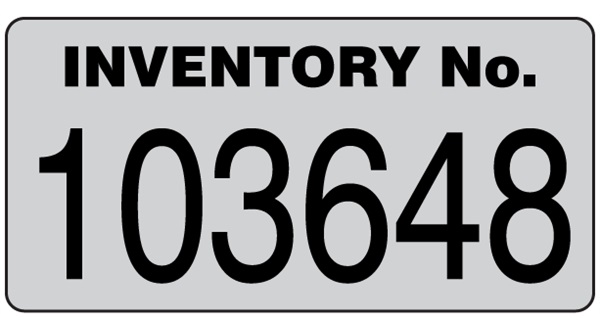
There are numerous reasons why someone might need jumbo-sized asset labels for their goods and products. Their increased size makes them easily visible from greater distances, which is ideal for a crowded warehouse, but these asset labels are also ideal for large-scale assets such as plant machinery and heavy-duty factory equipment.
All of this is just the tip of the iceberg - we have a huge range of asset labels to choose from, allowing us to meet almost any set of requirements. Click here to view our full range, or use our Asset Tag Builder to create customised asset labels of your own!

The House of Commons begins its summer recess later this month, which means that 'Silly Season' is almost upon us once more. Sily Season is that time of year when newspapers, in lieu of any important parliamentary developments to follow, start writing about any frivolous non-story they can get their hands on - prepare to see a lot of scaremongering, false moral panics, and general nonsense over the next couple of months as the papers desperately try to keep their readers interested.
Sadly, another staple of Silly Season is the 'elf and safety gone mad' story. Here's a good example from the Evening Express website, published a week ago:
Here's the problem: Aberdeen City Council may or may not be in the wrong here, but the newspaper is using the dispute to reinforce the idea that health and safety is here to ruin everyone's fun, rather than to save our lives. This play equipment story is a relatively tame example, too; far sillier stories made the news last summer, with everything from Frisbees to strawberry sauce reportedly being banned for health and safety reasons.
We're not just blaming the newspapers here. After all, these ridiculous stories make for rather funny reading, and the vast majority are true - many companies do use health and safety as an excuse for bizarre, nonsensical decisions, and that's clearly the root of this problem. Even so, newspapers make matters far worse by devoting column inches to these daft stories; if the British public are constantly being told that health and safety is stupid, it won't be long before they start believing it.
For instance, have you ever heard someone complain about the 'nanny state' or dismiss important safety measures as 'unnecessary red tape'? If so, you've already witnessed the effect that silly 'elf and safety' stories can have on people's attitudes. Stories like that one from the Evening Express teach us that health and safety is exclusively for spoilsports and wet blankets, when in fact health and safety regulations - the real ones, mind you - are in place to protect us.
So, this Silly Season, ignore any reports of 'elf and safety gone mad' and instead spread the word about why health and safety is so utterly important to the Great British public. Safety signs, warning labels, and all those other safety precautions are there for a reason, and sometimes the silly stories can make us forget that!
More health and safety insight here.
Newspaper photo by Jon S
Signs are an important part of any health and safety initiative, and one police officer has been demonstrating just how much difference a few safety signs can make with an inspirational safety campaign in Cambridgeshire.
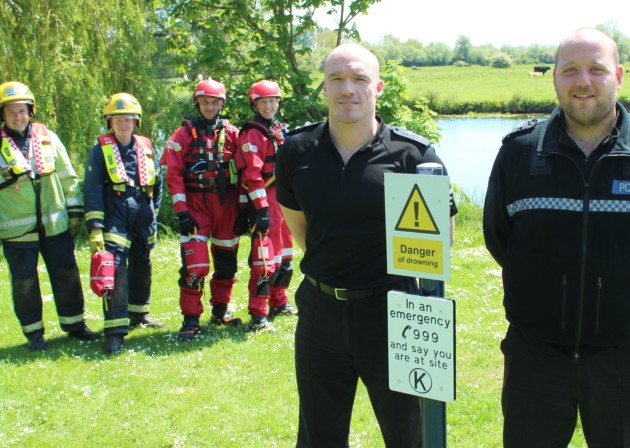
Photograph from www.huntspost.co.uk
Sergeant Mike Jackman was one of the first officers on the scene when a 15-year-old boy named Rony John drowned in the River Great Ouse in July 2014. Sgt Jackman's first-hand experience of this tragedy prompted him to come up with a means of making Cambridgeshire's waterways safer, particularly for young people - when accidents do happen around large bodies of water, children and teenagers are the most common victims.
One year on from the drowning incident that claimed Rony John's young life, Mike Jackman has unveiled a new safety sign scheme of his own devising that makes it easy for people to get help in the event of an accident. The usual water safety signs are in place, of course...
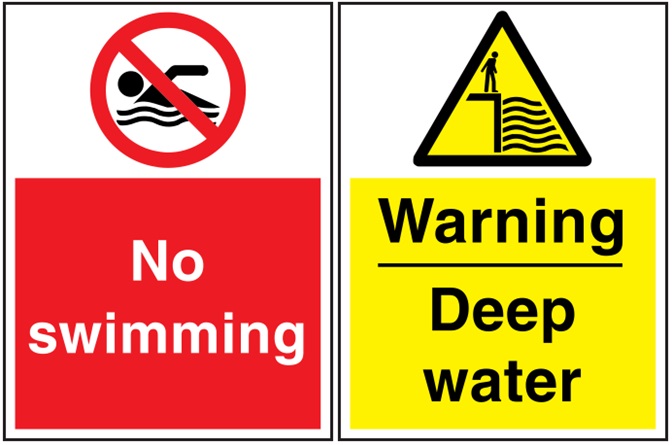
...but Sgt Jackman has also added some signs of his own. These signs are positioned underneath the standard safety signs, and each one provides instructions on what to do in an emergency. For example:
In an emergency, dial 999 and say you are at site K
The thinking behind this system is quite simple: if a young person is drowning in a river or another large body of water, their friends are frequently unable to accurately identify their location to the 999 operator. Mike Jackman's signs make it easy for youngsters to specify exactly where they are when phoning for help, allowing emergency services to get there quicker and save the person or people in danger.
Every second counts in an emergency situation, and we think that Sergeant Jackman's signage system is quite ingenious. With summer now upon us, the temperature is high throughout the UK, and more and more people will be tempted to use rivers, lakes, reservoirs, and other large bodies of water to cool off. It is at this time of year that water safety is most crucial, so please obey safety signs at all times and, if you are responsible for public health and safety, consider going above and beyond with your signage system like the Cambridgeshire Police have!
Visit our Water Safety Signs page to browse and buy our comprehensive range of signs and notices for potentially hazardous bodies of water.
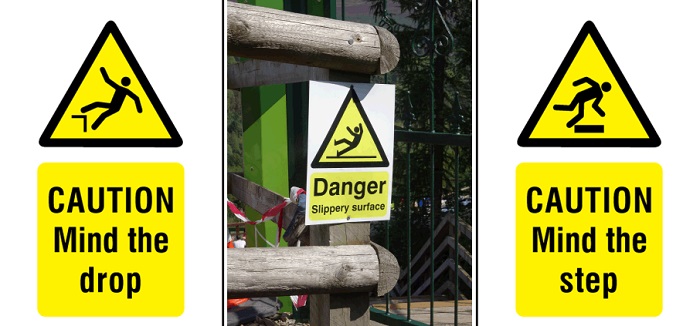
Slips, trips and falls are all too common in the modern workplace. The Health and Safety Executive has stated that they are "the single most common cause of major injury in UK workplaces", and that's not a not difficult claim to believe; not only can the fall itself result in severe injuries, it can lead to even more serious accidents if, for example, the victim falls into a piece of machinery or another hazard.
Here are some more statistics from the HSE:
- In 2013/14, slips, trips and falls were to blame for 29% of fatal workplace injuries
- Slips, trips and falls were responsible for 57% of all major/specified injuries to workers in 2013/14
- Over this period, a total of roughly 1.5 million working days were lost due to slips, trips and falls.
(Note that the phrase 'slips, trips and falls' covers a variety of different incidents, ranging from slipping on a wet floor or tripping over a loose floorboard to falling from height.)
So how can I prevent slips, trips and falls in my workplace?
We're glad you asked! With so many UK workers getting injured (or worse) by slips, trips and falls, employers need to everything they can to minimise the risk of a serious accident occurring. Here are some things that you can do to protect your employees:
- Use the correct hazard warning signs to make people aware of any potential risks (such as slippery surfaces, sudden drops, or trip hazards)
- Keep an eye out for any obstacles that could cause someone to trip over; common examples include bins, furniture, cables/wires, and desk drawers that have been left open
- Clean up any spills ASAP to prevent slips
- Always use a wet floor sign when cleaning is in progress
- If your employees are working at height, ensure that they are using the correct fall prevention equipment
- Train your staff to work safely and avoid slips, trips and falls (for example, do your employees know how to safely use a ladder?)
Visit our Slips, Trips & Falls department for more information and to purchase fall prevention signs for your workplace.
You probably heard about the Queen's asbestos problems earlier this week (and if you didn't, go and read the blog we wrote about it). Here are some other health and safety stories that didn't get quite so much attention this week...
Stafford Borough Council were hit with a £20,000 fine (plus costs) on Wednesday after an HSE inspection found that "a suitable risk assessment had not been carried out" at a local theatre. The investigation was carried out after a 33-year-old worker was injured in a fall at Stafford Gatehouse Theatre and left unable to work for more than two months afterwards.
*
A company in West Yorkshire has admitted to breaching health and safety regulations in relation to a fatal incident that occurred in late 2012. Keith Jarman, a 65-year-old man from Doncaster, was killed by a falling metal cage roughly two and a half years ago whilst making a deliver to an Oasis store in Hebden Bridge; the managing director of Oasis Limited entered a guilty plea on Wednesday, and the company will be sentenced in September.
*
Car manufacturers Hyundai are under fire in America, with the United Auto Workers union petitioning for health and safety improvements in the company's factories. According to Buzzfeed, the workers are particularly concerned about "exposure to unsafe chemicals" - read the full story here.
*
Finally, a couple of updates from Alton Towers, which is still reeling from the much-publicised Smiler crash earlier this month. The theme park has re-opened its gates since the accident, but visitors are complaining that too many attractions have been closed, with many suggesting that Alton Towers should lower their admission prices to reflect this.
According to the Express & Star, "Park-goers...have queued up for more than an hour for some attractions only to see them shut with no prior warning for safety testing." However, a representative for Alton Towers stated, "any delays that we are experiencing now are within our expected level."
Meanwhile, Joe Pugh - one of the people injured in the Smiler crash - was released from hospital on Tuesday; according to the Daily Star, Joe, his girlfriend Leah Washington (who had her leg amputated in the wake of the accident), and a third victim have all received payouts from the theme park's insurers.
More health and safety news and insight here.